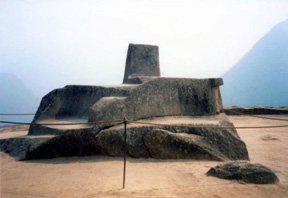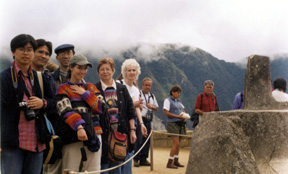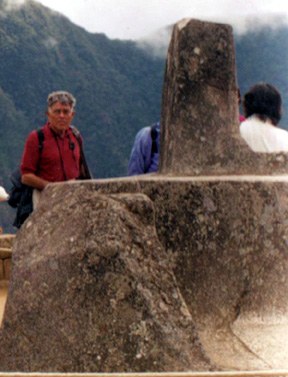|
YACHAY WASI - INKA CHALLENGE:
From desecration of human remains to sacred sites…
One basis of racism and religious intolerance,
propagated by Western scholars, has been to denigrate the pre-Columbian
religions as pagan worship of "gods" such as sun god or mountain god in
Inka religion. One of its consequences has been the desecration by
scientists of Inka burial sites in the Andes and display of Indigenous
remains. These ancient religions worshipped the one Creator and revered
other entities as "spirits" who are not gods, but emanations from the
Creator or symbols of the Creator's spiritual power.
Spirituality, which expresses itself in religion, is at the core of the
fabric of human beings. Religions, especially ancient religions, are not
evaluated for their true meanings and are denigrated by others who think
they know best because of misconceptions carried thru centuries by
clergies, universities, press, magazines, television, films etc…This is
particularly the case with the religion of the Inkas.
As outlined in the Draft Declaration on the Rights of Indigenous Peoples,
Indigenous peoples want their religions to be recognized as for instance
Native American religions were recognized in 1978 and protected by law in
the US since 1990 or the Maya religion which was recognized in the recent
peace process in Guatemala.
Excerpt from Part III, Article 13 - UN Draft Declaration on the Rights
of Indigenous Peoples:
"Indigenous Peoples have the right to manifest, practice, develop and
teach their spiritual and religious traditions, customs and ceremonies;
the right to maintain, protect, and have access in privacy to their
religious and cultural sites; the right to the use and control of
ceremonial objects and the right to the repatriation of human remains.
States shall take effective measures, in conjunction with the indigenous
peoples concerned, to ensure that indigenous sacred places, including
burial sites, be preserved, respected and protected."
The INKA CHALLENGE when started in 1996 by Yachay Wasi was:
"Will American scientists and their American non-profit sponsors
respect Indigenous Peoples' spiritual heritage in foreign countries?"
Prompted by NY Times article May 8, 1996 "Archeologists in Peru
oppose loan of Inca Mummy to US" announcing the May 21- June 19, 1996
exhibit of a 500 years old Inca young girl's remains at Washington DC
headquarters of National Geographic Society, Yachay Wasi started its Inka
Challenge Campaign with a petition against the exhibit.
Between 25 May and 5 July 1996, besides numerous press releases and
letters to magazines and newspapers, letters were sent to President
Clinton, Senator Moynihan, Reg Murphy, then President of National
Geographic Society, archeologist José Antonio Chavez, Peru, Dr. Konrad
Spindler, Austria, Dr. Sonia Guillén, Peru and several letters to
archeologist Johan Reinhard who was very insulting and threatened law
suits until he made an unexpected visit to the home of Yachay Wasi
President Luis Delgado Hurtado in Cuzco, Peru in July 1996.
Yachay Wasi Inka Challenge resulted in a paragraph on page 3 of the UN
brochure published in February 1998 as part of the UN Press Kit for the
50th Anniversary of the Universal Declaration of Human Rights. Title:
"Indigenous People: Challenges facing the international community".
1998: INKA CHALLENGE phase 2: Campaign against Florida
International Museum Exhibit "Empires of Mystery: The Incas, the Andes and
Lost Civilizations" opening on October 23, 1998 "in time for Halloween"
thru April 25, 1999 in St Petersburg, Florida. This campaign was done in
cooperation with Sheridan Murphy, American Indian Movement of Florida. A
statement was sent to the 4th World Archeological Congress taking place in
January 99 in Cape Town, South Africa.
1999: INKA CHALLENGE phase 3: Unearthing of Inka children's remains
in the Andes: Johan Reinhard finds and removes 3 Inka children from the
Andes. NY TIMES article April 7, 1999 The campaign against the Florida
International Museum had a fitting ending in April 1999 when the issue of
Desecration of Indigenous Burial Sites and Display of Indigenous Remains
was presented by Yachay Wasi to the Human Rights NGO Caucus of the UN
Commission on Sustainable Development 7th Session. One of the issues that
year was Sustainable Tourism. On the actual date of the exhibit
closing, the Human Rights NGO Caucus decided to include the issue in its
report to the UN Commission.
Conclusions:
Since then, many TV programs National Geographic, Discovery Channel, Nova
and these programs websites continue to display remains of Indigenous
Peoples. Occasionally we send an email of protest but it really does not
go anywhere… In 1999, Marie-Danielle Samuel had a meeting with an officer
of the NY Office of the High Commissioner for Human Rights and
subsequently met briefly Mr Abdelfattah Amor, Special Rapporteur on
Religious Intolerance. UN conventions established so far do not cover
desecration of burial sites and display of Indigenous remains.
ILO 169 and the Draft Declaration on the Rights of Indigenous Peoples
do cover this, but are not binding.
Note: A letter to NY Times commenting on the misconception of Inka
religion shown in a January 2, 2000 Travel article was printed on January
30, 2000 showing that the press is ready to revise old concepts.
TO SACRED SITES: In June 2001, Yachay Wasi, which had just been
granted consultative status with ECOSOC, organized its first Encounter
of Indigenous Communities in the High Andes in the village of Acopia,
Dept of Cuzco, Peru. This event was prepared in collaboration with the
Office of the High Commissioner for Human Rights which sent a
representative. At the end of the 5-days meeting, a statement was faxed to
UNESCO World Heritage Centre asking that Machu Picchu be recognized and
respected as a Sacred Site and that Indigenous Peoples have a say in its
protection so that incidents such as the chipping of the ancestral stone
of Inti Watana by a beer commercial crane in September 2000 can be
prevented in the future.
A direct result was the funded invitation by UNESCO World Heritage Centre
for Luis Delgado Hurtado, President of Yachay Wasi, to travel from Cuzco,
Peru to attend the Proposed World Heritage Indigenous Peoples Council of
Experts (WHIPCOE) Winnipeg Workshop in November 2001.
This event prompted Marie-Danielle Samuel, Main Representative to the UN
for Yachay Wasi, to originate in November 2001 the concept of a Panel
Discussion during the historic First Session of the United Nations
Permanent Forum on Indigenous Issues 13-24 May 2002 at UN Hqrs in NYC. A
member since its inception on 16 October 1991 of the NGO Committee on the
UN International Year of the World's Indigenous Peoples, now on its
International Decade, she coordinated this Panel on behalf of the NGO
Committee. What was meant to share the good news of WHIPCOE became a quest
to keep it alive after the World Heritage Committee turned down its
implementation in December 2001.
To widen the scope of interest, she suggested the involvement of
Indigenous communities around the world by sending a Call for Submissions
on Sacred sites issues. This idea was approved at the 21 March 2002
general meeting of the NGO Committee on the UN International Decade of the
World's Indigenous Peoples.
A report of the NYU 15 May 2002 Panel Discussion "During the
International Year of Cultural Heritage - Cultural Heritage and
Sacred Sites: World Heritage from an Indigenous perspective" will be
presented to the 16 members of the UN Permanent Forum on Indigenous Issues
to ensure that these issues be included in their future agendas.
Ironically, on the same evening of this panel, PBS TV Ch 13 in NYC is
broadcasting National Geographic's latest 4-year long unearthing of some
2000 Inka "mummies" near Lima, Peru. The question is: How many bodies are
needed to satisfy science?
The ongoing search by scientists of ancient Indigenous remains, on the
guise of preventing grave robbers and in fact becoming grave robbers
themselves, must stop.
The display, for whatever reasons, of Indigenous remains must stop.
In the words of the 1998 Press Release from the American Indian Movement
of Florida: "Would the Florida International Museum dig up the
honorable John F. Kennedy and place his remains on display as a tourist
attraction?"
In 2002, the Inka Challenge has become:
"Will world governments, scientists, non-profit sponsors and tourists
respect Indigenous Peoples' spiritual heritage: religion, burial sites and
human remains and will the International community respect and allow them
to protect their sacred sites?"
9 May 2002
YACHAY WASI (House of Learning) N G O / U n i t e d N a t i o n s E C O S
O C & D P I - NYC - Cuzco, Peru
708 West 192nd St. # 6B, New York, NY 10040-2450 USA
Tel: 212-567-6447 - Fax: 917-529-0922
La Conquista 3 puerta, Saphi - Cuzco, Peru
Tel: 51- 84 -252618 Email:
yachaywasi@igc.org
www.yachaywasi-ngo.org

Inti Watana, in Machu Picchu, taken in 1996 by Luis Delgado Hurtado |

Photo taken on June 22, 2001, day after Yachay Wasi Encounter of
Indigenous Communities in the High Andes. Posing left to
right: Tzu-Ming Liu, Rev. Namoh Ising and Jason Pan (Taiwan), Rachel
Groux (OHCHR), Marie-Danielle Samuel (Yachay Wasi) |

Detail of Inti Watana showing break |
|


